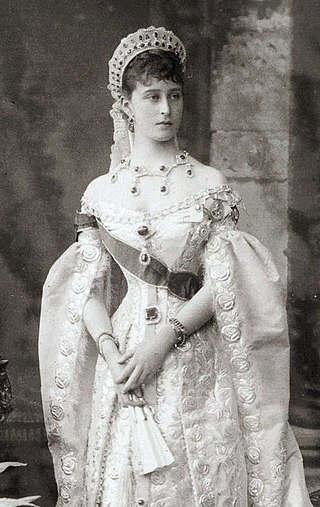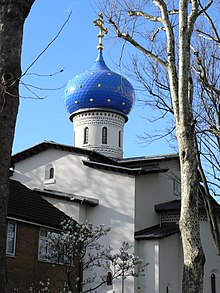
In the Christian liturgical calendar, there are several different Feasts of the Cross, all of which commemorate the cross used in the crucifixion of Jesus. Unlike Good Friday, which is dedicated to the passion of Christ and the crucifixion, these feast days celebrate the cross itself, as the sign of salvation. In Western Catholicism, Eastern Catholicism, Eastern Orthodoxy, Oriental Orthodoxy, Lutheranism and Anglicanism the most common day of commemoration is 14 September, or 27 September in churches still using the Julian calendar.

The Russian Orthodox Church Outside of Russia, also called Russian Orthodox Church Outside Russia or ROCOR, or Russian Orthodox Church Abroad (ROCA), is a semi-autonomous part of the Russian Orthodox Church. Currently, the position of First-Hierarch of the ROCOR is occupied by Metropolitan Nicholas (Olhovsky).

Grand Duchess Elizabeth Feodorovna of Russia was a German Hessian and Rhenish princess of the House of Hesse-Darmstadt, and the wife of Grand Duke Sergei Alexandrovich of Russia, the fifth son of Emperor Alexander II of Russia and Princess Marie of Hesse and by Rhine.

The Cathedral of St. Sophia, the Holy Wisdom of God in Veliky Novgorod, Russia, is the cathedral church of the Metropolitan of Novgorod and the mother church of the Novgorodian Eparchy.

Marfo-Mariinsky Convent, or Martha and Mary Conventof Mercy in the Possession of Grand Duchess Elizabeth Feodorovna is a women's convent in Moscow.
In Christianity, the Nativity Fast—or Fast of the Prophets in Ethiopian Orthodox Tewahedo Church and Eritrean Orthodox Tewahedo Church—is a period of abstinence and penance practiced by the Eastern Orthodox Church, Oriental Orthodox Church and Catholic Church in preparation for the Nativity of Jesus on December 25. Ethiopian and Eritrean Orthodox Churches commence the season on November 24 and end the season on the day of Ethiopian Christmas, which falls on January 7. The corresponding Western season of preparation for Christmas, which also has been called the Nativity Fast and St. Martin's Lent, has taken the name of Advent. The Eastern fast runs for 40 days instead of four or six weeks and thematically focuses on proclamation and glorification of the Incarnation of God, whereas the Western Advent focuses on three comings of Jesus Christ: his birth, reception of his grace by the faithful, and his Second Coming or Parousia.

The Feast of Orthodoxy is celebrated on the first Sunday of Great Lent in the Eastern Orthodox Church and other churches using the Byzantine Rite to commemorate, originally, only the final defeat of iconoclasm on the first Sunday of Lent in 843, and later also opposition to all heterodoxy.

A Paraklesis or Supplicatory Canon in the Byzantine Rite, is a service of supplication for the welfare of the living. It is addressed to a specific Saint or to the Most Holy Theotokos whose intercessions are sought through the chanting of the supplicatory canon together with psalms, hymns, and litanies.

The canonization of the Romanovs was the elevation to sainthood of the last Imperial Family of Russia – Tsar Nicholas II, his wife Tsarina Alexandra, and their five children Olga, Tatiana, Maria, Anastasia, and Alexei – by the Russian Orthodox Church.

John Alexandrovich Kochurov, hieromartyr of the Soviet revolution, was one of a number of young educated priests who came to the United States in the late 1890s as missionaries among the émigrés from Carpathian Ruthenia and Galicia. He was active in establishing parishes and aiding communities, mainly in the Midwest. After returning to Russia he was assigned to Estonia where he put into action the teaching skills he learned in America before he was assigned in 1916 to Tsarskoe Selo. Here he was killed during the early days of the Bolshevik revolution. His feast day is celebrated on October 31. He is also commemorated on the Synaxis of the first martyrs of the American lands on December 12 and on the feast of the New Martyrs and Confessors of Russia, celebrated on the Sunday nearest to January 25, which was the date of the martyrdom of Metropolitan Vladimir of Kiev, the first of the new martyrs.

The coronation of the emperor of Russia from 1547 to 1917, was a highly developed religious ceremony in which they are crowned and invested with regalia, then anointed with chrism and formally blessed by the church to commence his reign. Although rulers of Muscovy had been crowned prior to the reign of Ivan III, their coronation rituals assumed overt Byzantine overtones as the result of the influence of Ivan's wife Sophia Paleologue, and the imperial ambitions of his grandson, Ivan the Terrible. The modern coronation, introducing "Western European-style" elements, replaced the previous "crowning" ceremony and was first used for Catherine I in 1724. Since tsarist Russia claimed to be the "Third Rome" and the replacement of Byzantium as the true Christian state, the Russian rite was designed to link its rulers and prerogatives to those of the so-called "Second Rome" (Constantinople).

The Diocese of Great Britain and Western Europe is a diocese of the Russian Orthodox Church Outside Russia (ROCOR), encompassing all of western Europe but with communities primarily on territories of the United Kingdom, Switzerland and France.

December 19 - Eastern Orthodox liturgical calendar - December 21

December 25 – Eastern Orthodox liturgical calendar – December 27

The Diocese of Birobidzhan and Kuldur is a diocese of the Russian Orthodox Church, the centralized religious organization headed by Moscow Patriarchate. The diocese operates churches within the borders of the Jewish Autonomous Region which borders with China on the south, Amur Oblast on the west and Khabarovsk Krai on the northeast.
The ROCOR Canonical and Official Representation in the Philippines is a jurisdiction of the Eastern Orthodox Church under the Russian Orthodox Church Outside Russia, a semi-autonomous jurisdiction of the Moscow Patriarchate under Metropolitan Hilarion (Kapral), First Hierarch of the ROCOR. As of August 2013, there are four missions in the country.
Tsarebozhiye is a radical doctrine in the Russian Orthodox Church that believes Nicholas II is the redeemer of the sins of the Russian people, that for this reason he possessed a special nature, pure of sin, that Russia is the Kingdom of God on earth, and that his death was a collective sin of the Russian people that they must atone for, however, in keeping with the Christ analogy, it is also believed that his death prevented the emergence of the Antichrist.

Metropolitan Nicholas is the First Hierarch of the Russian Orthodox Church Outside of Russia and Metropolitan of Eastern America and New York since 14 September 2022.

Feodorovskaya Icon Cathedral — an Orthodox church in Saint Petersburg, Russia. It belongs to the Central Deanery of the St. Petersburg Diocese of the Russian Orthodox Church. The cathedral was built in Commemoration of the Romanov Tercentenary.

















